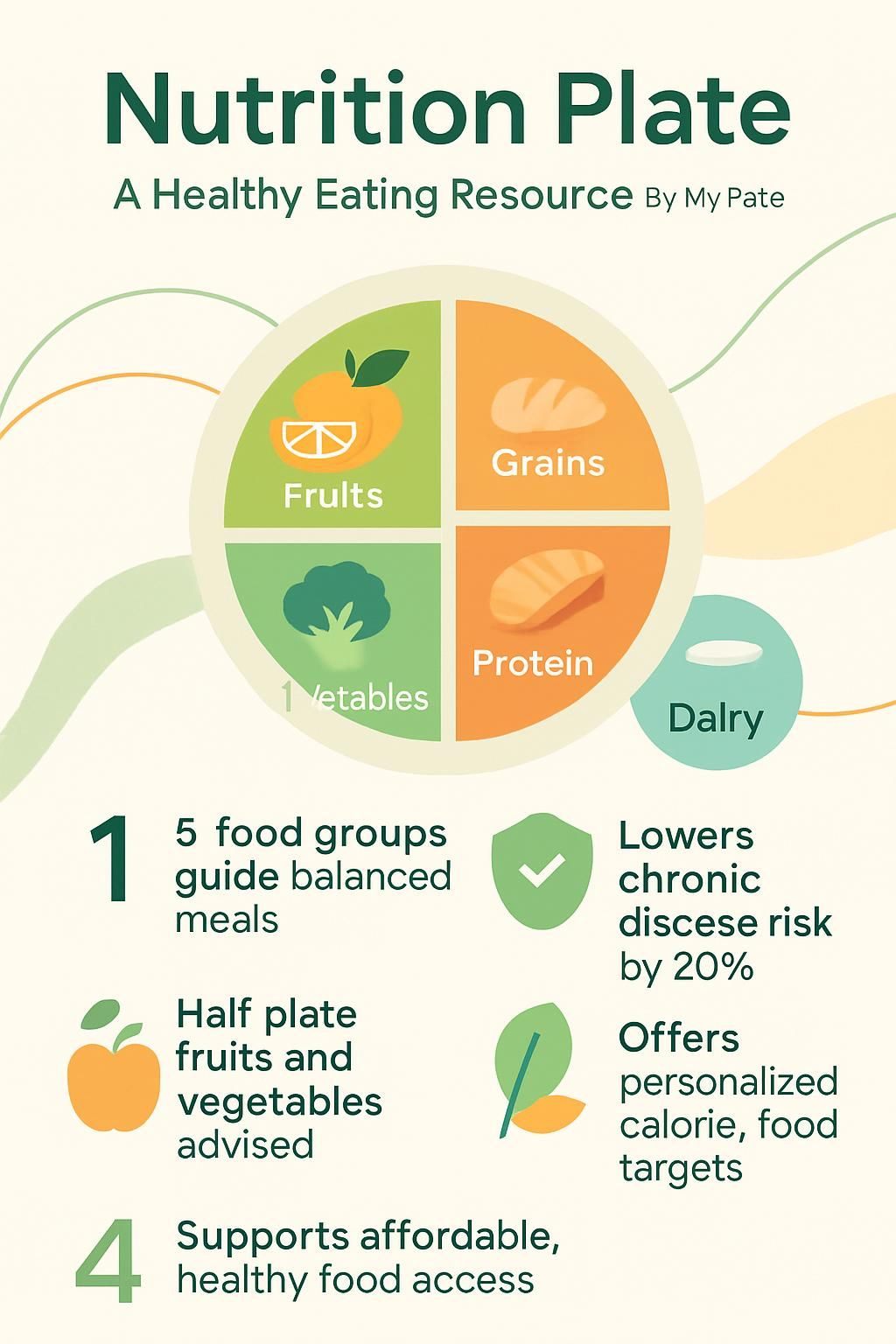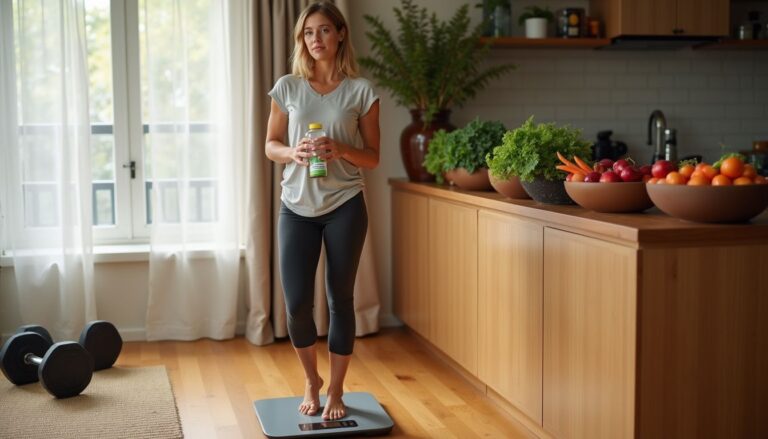Nutrition Plate: A Healthy Eating Resource By MyPlate
Our Nutrition Assistant AI Suite will transform your body. You will lose fat, get toned, and build muscle. Gain confidence and optimal health.
Healthy eating can feel confusing with so much advice online. MyPlate, the simple plate graphic from the U.S. Department of Agriculture, turns nutrition into clear steps you can use today. It helps you plan balanced meals that include every food group, a practical path to healthy eating.
This article shows how to use the Nutrition Plate to build meals with vegetables, grains, protein foods, fruit, and dairy. You will see how each group fits on your plate and why that balance matters for your health.
Use these tips to build better habits for you and your family, with easy steps you can start at your next meal.
Key Takeaways
- MyPlate, launched by the USDA in 2011, uses five food groups, fruits, vegetables, grains, protein foods, and dairy, aligned with the Dietary Guidelines for Americans, 2020–2025.
- Studies cited by Harvard and USDA-linked research report lower risks for chronic disease, up to about 20 percent, when people follow healthy eating patterns like MyPlate.
- MyPlate.gov and its app provide personalized calorie guidance, food group targets, label-reading help, and budget-friendly recipes for every age and many diets.
- Experts recommend half your plate as fruits and vegetables, choose whole grains, limit red meat and added sugars, and pick low-fat dairy options.
- Tools such as Shop Simple with MyPlate support SNAP shoppers with affordable choices, while the Nutrition Facts label helps match products to MyPlate goals.

What is MyPlate?

MyPlate is a teaching tool from the USDA that shows how to build a balanced plate. It links your meal to nutrient needs and helps you plan within your calorie target.
What is the MyPlate nutrition guide?
The MyPlate guide uses a plate image to show the right mix of food groups. Introduced in 2011, it supports the Dietary Guidelines for Americans, 2020–2025.
The plate is divided into five parts: fruits, vegetables, grains, protein foods, and dairy. Aim for plenty of fruits and vegetables with different colors for variety.
Include whole grains like brown rice or whole wheat pasta, lean proteins such as beans or chicken, and a dairy choice like yogurt or low-fat milk. This simple picture helps you choose nutrient-dense foods while staying within your calorie needs. Many health experts, including those at Harvard, support similar approaches for long-term wellness.
Why is MyPlate a useful healthy eating resource?
MyPlate offers clear, science-based advice that is easy to put into action. The guidance reflects research used in the Dietary Guidelines for Americans, which are updated every five years by USDA and HHS.
At MyPlate.gov you will find tools like My Saved Recipes, quizzes, daily food group targets, and budget tips. Printable resources support every age group, from infants to older adults, so you can set realistic goals that match your activity level and calorie needs.
With this foundation, choosing fruits for a balanced meal becomes much easier.
The Components of the MyPlate Nutrition Guide
MyPlate highlights five key food groups. Each group supports your health, and together they create meals that help you build steady habits.
What fruits should be included in MyPlate?
Choose a variety of colorful fruits. Whole fruits give you fiber and more nutrients than most juices.
- Pick apples, oranges, bananas, berries, or watermelon. Whole fruit usually beats juice for fiber and fullness.
- Most adults aim for about 2 cups of fruit per day. Adjust for age and activity.
- Bring color to meals with grapes, kiwi, strawberries, or mango. Variety supports disease prevention.
- Limit sweetened drinks and fruit punches. They add calories and may raise risk for obesity or heart problems.
- If you drink juice, keep it to one small glass of 100 percent juice per day. Whole fruit remains the better daily choice.
- Try MyPlate recipes that use fruit in salads and meals, such as pasta shells with pumpkin, for flavor without extra sodium or added sugar.
- Use MyPlate.gov to check portion sizes by age so you can stay within your calorie plan.
Next, see how vegetables fit into your plate for a stronger nutrition base.
How to include vegetables in your MyPlate?
Vegetables should fill the largest area on your plate. Making them the base of your meal boosts vitamins, fiber, and minerals.
- Choose many colors, dark greens, reds, oranges, and purples, to increase nutrient variety and flavor.
- Add vegetables to soups, salads, omelets, and mixed dishes. This keeps cooking flexible and simple.
- Skip French fries and similar items. They do not count as healthy vegetables on MyPlate or on the Healthy Eating Plate.
- Use fresh, frozen, or low-sodium canned vegetables to save time and money.
- Explore MyPlate Kitchen recipes to add new vegetables to your routine.
- Use Shop Simple with MyPlate to buy in-season produce at lower prices.
- Cook with less salt and less saturated fat to protect heart health.
- Aim for at least 2½ cups of vegetables per day, as advised by the USDA.
- Personal note: I swapped chips for carrot sticks at lunch. The crunch stayed, and my weight started to drop.
With vegetables in place, your grains are the next key piece.
Which grains are recommended by MyPlate?
Whole grains should be your default choice. They help manage blood sugar and support heart health.
- Top picks include whole wheat bread, whole grain pasta, and brown rice.
- Limit refined grains such as white bread, white rice, and regular pasta. These often lack fiber.
- Choosing whole grains improves overall diet quality.
- MyPlate sets daily whole grain targets by age and activity. Check your plan for details.
- Grains are one of the five core groups. Try to include them in most meals.
- More whole grains support better carbohydrate balance and may lower chronic disease risk.
- Filter by grain type in MyPlate Kitchen to find new, tasty recipes.
What protein sources are part of MyPlate?
Protein foods support muscles, hormones, and immune function. Quality matters as much as quantity.
- Choose fish, poultry, beans, and nuts often. These provide lean protein and healthy fats.
- Limit red meat like beef and pork. Higher intake links to increased disease risk.
- Avoid processed meats such as bacon and deli slices. They raise sodium and health risks.
- Use the MyPlate Plan to set your protein servings for age, sex, and activity.
- Pick plant proteins, lentils, tofu, and peas, if you eat vegetarian or vegan meals.
- Visit MyPlate Kitchen for portion-smart recipes with healthy proteins.
- Focus on nutrient-dense choices over large amounts of less healthy proteins.
- Dairy has its own group on MyPlate, separate from protein foods.
- In my meals, I now use more beans and fish. They are quick to cook and keep my plate balanced.
This approach aligns with current guidance and makes meals both nutritious and satisfying.
How does dairy fit into MyPlate?
Dairy has its own place on the plate. It contributes calcium and protein for bones and muscles.
- MyPlate shows dairy as a separate group that supports a well-rounded meal.
- Choose milk, cheese, or yogurt to meet dairy needs.
- The Healthy Eating Plate suggests about 1 to 2 servings per day for most adults.
- Water, tea, or coffee without much sugar are better daily drinks than milk alone.
- If lactose is an issue, try lactose-free milk or fortified soy beverages.
- Browse MyPlate.gov for recipes that include dairy while keeping meals balanced.
- Use the MyPlate Plan to set your personal dairy target by age and activity.
- Limit juice and sweetened dairy drinks to reduce added sugars.
- Use the Nutrition Facts label to choose lower-fat, lower-sugar dairy products.
- Appropriate dairy intake can support bone health while helping muscles work well.
Benefits of Using MyPlate for Healthy Eating
MyPlate is a daily reminder to vary your foods and build balance. Small steps add up to healthier eating patterns over time.
How does MyPlate encourage balanced meals?
The MyPlate image divides your meal into five parts, fruits, vegetables, grains, protein foods, and dairy. Vegetables and fruits take the most space to make their importance clear.
Use the picture as a quick check. Half your plate is fruits and vegetables, one quarter grains, one quarter protein, plus a dairy serving. The guide also stresses food quality, like whole grains and lean proteins.
I use the MyPlate layout at home. My kids now ask for veggies because they can see how much space they should fill. The MyPlate Plan lets you enter age, sex, and activity to personalize the balance for your needs.
This prepares you for portion control, a core habit for long-term health.
How can MyPlate help with portion control?
MyPlate helps you see how much space each group should take on your plate. That visual estimate keeps portions in check. The MyPlate Plan also adjusts serving sizes for age, sex, height, weight, and activity level.
Use the Start Simple with MyPlate app to set daily goals and track servings for each group. Shop Simple with MyPlate offers portion tips that fit your budget while you shop. Limiting refined grains and red meat supports healthy portions as recommended by many nutrition experts.
Quiz results on MyPlate show if your meal sizes match current guidelines. My Saved Recipes makes planning the right portion sizes easier each day.
How does MyPlate promote long-term health and prevent disease?
Following MyPlate steers you toward whole foods and plant-forward meals, while reducing sugary drinks, red meat, and ultra-processed snacks. Research linked to USDA measures found that higher Healthy Eating Index scores connect to lower chronic disease risk over time.
Harvard analyses report sizable benefits, including about 20 percent lower risk of major chronic disease for men and notable heart health gains for men and women. Large cohort studies in the United Kingdom and the United States show reduced mortality and fewer heart disease deaths among those with higher diet quality scores.
Improvements in diet quality across the population between 1999 and 2010 were also tied to better health outcomes. Next, see how to tailor MyPlate to your needs.
How to Personalize Your MyPlate Plan
Personalization turns a good plan into your plan. Adjust for age, activity level, health goals, and food preferences.
How do you determine your calorie needs?
Your calorie target sets the frame for portions and food group goals. A few details give you a solid estimate.
- Go to MyPlate.gov and open the MyPlate Plan tool to estimate daily calories.
- Enter age, sex, height, weight, and physical activity level. These drive your needs.
- Review your target. Plans usually range from about 1,200 to more than 3,000 calories per day.
- Track intake with the Start Simple app to stay near your target and support your goals.
- Update your details as weight, age, or activity changes. The plan will adjust automatically.
- Take the MyPlate quiz for feedback on how your eating compares to recommendations.
- Use your results to set servings for each food group that match your calorie level.
- Adjust calories for weight loss, maintenance, or gain, and make changes gradually.
- Keep balance in mind. The Healthy Eating Plate emphasizes proportions, not just numbers.
- For me, tracking in the app showed where to add vegetables and reduce snack calories. Progress came faster once I saw the pattern.
How to set food group targets by age and activity level?
Food group targets shift across life stages and with activity. The MyPlate Plan personalizes those numbers for you.
- Use the MyPlate Plan at MyPlate.gov to enter age, sex, height, weight, and activity.
- Review your daily targets for fruits, vegetables, grains, protein, and dairy. These change from childhood through older adulthood.
- Very active people often need higher targets for grains, protein, and calories.
- Children have lower targets that rise as they grow and move more.
- The Start Simple app updates goals as you log meals and share progress.
- Shop Simple with MyPlate offers low-cost options to meet each group target.
- Review your plan yearly, or after growth spurts or changes in training routines.
- As a daily runner, my grain and protein targets increased once I updated my profile. I added whole wheat bread and eggs to match the new goals.
Next, see how to adapt MyPlate for preferences or dietary limits.
How can you adapt MyPlate for personal preferences and dietary restrictions?
MyPlate is flexible. You can meet the guidelines while honoring culture, taste, and medical needs.
- Use plant proteins like beans, peas, tofu, and nuts for vegetarian or vegan meals.
- Choose lactose-free milk or fortified soy drinks if you need dairy alternatives. These provide calcium and vitamin D.
- Filter MyPlate Kitchen recipes for allergies or needs such as gluten-free or peanut-free.
- Pick whole grains that fit your culture, brown rice, corn tortillas, or quinoa.
- Adjust serving sizes in the MyPlate Plan for pregnancy, goals, or activity level.
- Include foods from your traditions by matching them to each food group.
- Save favorite recipes in your MyPlate cookbook for faster planning.
- Sign up for emails with tips for kids, teens, adults, older adults, or pregnancy.
- Seek guidance from a registered dietitian for complex needs or medical conditions.
- Try new foods within each group to increase variety and keep meals interesting.
MyPlate Tools and Resources
The right tools make healthy choices easier to start and easier to keep.
Features of the MyPlate.gov website
MyPlate.gov runs on a secure .gov domain with HTTPS. You can create an account to save recipes, build cookbooks, and view your MyPlate Quiz results.
Account tools help you track goals and adjust preferences. Printable materials support lessons at home or in class, including resources for pregnancy and older adults.
The site reflects updates to the Dietary Guidelines for Americans soon after release. In rare cases, budget delays can pause updates, as happened in late 2025. Across life stages, the website offers clear guidance and trustworthy materials.
Using the Start Simple with MyPlate app
The Start Simple app helps you build habits one goal at a time. Set daily targets such as eat a vegetable at lunch or choose low-fat milk.
Track progress and earn badges as you hit streaks. Tips adjust to your age and activity level, and your data stays in sync with MyPlate.gov. Last month I used it to improve my grain choices, and small steps added up quickly.
How to use MyPlate on Alexa
Use an Amazon Alexa device for hands-free nutrition tips. Say, “Alexa, open MyPlate,” to get serving sizes, meal ideas, and quick reminders while you cook.
Voice access is helpful when your hands are busy or mobility is limited. I asked which grains fit my lunch plan while prepping food, and it gave a clear answer in seconds.
How Shop Simple with MyPlate helps with grocery shopping
Shop Simple with MyPlate supports budget-savvy shopping. It highlights affordable items, seasonal picks, and low-cost recipes that match your plan.
If you use SNAP, Shop Simple shows tailored tips and local deals. You can also build lists that tie to your recipes and stretch every dollar toward healthy foods.
Using MyPlate Alongside the Nutrition Facts Label
Pair the plate picture with the label on the package. Together they point you to smart, balanced choices.
How can you understand food labels?
Food labels guide smart choices at home and in the store. MyPlate.gov offers simple steps for reading Nutrition Facts.
- Check the serving size at the top. It sets the base for calories and nutrients.
- Look at calories per serving. Compare this number with your daily target.
- Scan nutrients, protein, carbs, fats, vitamins, and minerals. Aim higher for fiber, calcium, iron, and key vitamins.
- Watch for added sugars and trans fats. Keeping these low reduces health risks.
- Use sodium to guide your limit, generally less than 2,300 milligrams per day.
- Compare labels side by side to find better options. Shop Simple can help during store visits.
- MyPlate.gov includes real label examples to build your skills.
- Join workshops or read guides to become a confident label reader.
Using labels often helps you control ingredients and hit your healthy eating goals.
How to make informed food choices using nutrition labels?
Label reading turns package claims into clear facts. Use these checks to support your MyPlate goals.
- Start with serving size. Many packages contain more than one serving.
- Choose foods that list whole grains first, such as 100 percent whole wheat.
- Focus on protein quality. Pick chicken, fish, beans, or tofu over processed meats.
- Compare fat types. Select items with healthy oils and avoid partially hydrogenated oils.
- Scan for added sugars such as high fructose corn syrup or glucose. A simple limit is less than 10 grams per serving.
- Choose lower sodium items. For low-sodium foods, look for 140 milligrams or less per serving.
- Use Shop Simple for label-based tips that also reduce food waste.
- Try label-reading challenges in the Start Simple app to build confidence.
- Search MyPlate Kitchen for recipes that fit your label goals and portion needs.
- Set goals to cut refined grains. Choose brown rice or quinoa instead of white bread or regular pasta.
- From my weekly shopping, checking labels helped me find hidden sugars in cereal. That single habit made breakfast much healthier for my family.
Healthy Eating Tips with MyPlate
Healthy and easy can live on the same plate. These ideas keep costs and time under control.
What are some budget-friendly meal ideas with MyPlate?
You can meet nutrition goals without spending more. Smart planning brings cost down and quality up.
- Use Shop Simple to filter recipes by price and local availability.
- Browse MyPlate Kitchen for low-cost meals across all food groups. Many cost under two dollars per serving.
- Pick seasonal produce, like apples in fall or carrots in spring, for better prices and taste.
- Cook big batches of whole grain pasta salad with beans, vegetables, and low-cost proteins such as eggs or canned fish.
- SNAP shoppers can access special tools that stretch benefits while meeting nutrition needs.
- Make lists that focus on bulk staples, rice, oats, beans, and frozen vegetables.
- Try filling dishes like black bean chili or veggie stir-fry with budget-friendly ingredients.
- Meal prep once, then eat balanced leftovers during the week.
- Swap high-sodium packaged meals for homemade recipes with simple ingredients.
What are easy and quick recipes using MyPlate?
Quick recipes can still be balanced and flavorful. Use these ideas to fit healthy meals into busy days.
- Try Pasta Shells Stuffed with Pumpkin and Ricotta from MyPlate Kitchen. It cooks in under 45 minutes.
- Use the Start Simple app to find fast lunches and dinners that hit every group.
- Save favorite recipes to My Cookbooks for easy access later.
- Print recipe cards from MyPlate.gov for busy weeknights.
- Make stir-fries with chicken or tofu, whole grain rice, and mixed vegetables.
- Create fruit and yogurt parfaits for breakfast to cover dairy and fruit.
- Filter MyPlate Kitchen by prep time and pick recipes ready in 30 minutes or less.
- Choose budget meals like bean chili or veggie omelets, supported by Shop Simple.
- Pack snack boxes, whole wheat crackers, cheese, carrots, and apple slices, to cover groups on the go.
- Try sheet pan dinners. Roast fish, potatoes, and broccoli together for fast cleanup.
- Health educators can share MyPlate.gov materials to help others find simple, balanced recipes.
How to incorporate whole grains, fruits, and vegetables?
These foods are the core of your plate. They add fiber, vitamins, minerals, and flavor.
- Choose whole wheat bread, whole grain pasta, or brown rice most of the time.
- Fill half your plate with colorful fruits and vegetables at each meal.
- Use Shop Simple to find affordable whole foods like apples, canned corn, or frozen peas.
- Pick recipes that combine grains and produce in one skillet or bowl.
- Track daily servings in the Start Simple app to stay on target.
- Buy a new fruit or vegetable each week for variety.
- Add fruit to oatmeal and extra vegetables to sandwiches, soups, or pasta.
Reducing sodium, added sugar, and trans fats also strengthens your plan.
How to reduce sodium, sugar, and trans fats in meals?
Cutting these lowers disease risk and supports steady energy. Small swaps go a long way.
- Read labels to spot high sodium, added sugars, and trans fats before you buy.
- Choose fresh produce instead of canned items packed with salt or syrup.
- Cook at home more often so you control ingredients and portions.
- Swap processed meats for chicken breast, fish, or beans to lower sodium.
- Use canola or olive oil instead of butter or hard spreads that may include trans fats.
- Pick MyPlate Kitchen recipes that feature less salt and fewer added sugars.
- Drink water, tea, or coffee without sugar instead of sweetened beverages.
- Use Shop Simple to find lower-sodium options that fit your budget.
- Get daily swap tips in the Start Simple app.
- Limit fast food and packaged snacks, common sources of hidden sodium and trans fats.
MyPlate and Physical Activity
Food fuels your day, and movement helps your body use that fuel well.
Why combine healthy eating with regular exercise?
Nutrition and activity work better together than alone. Balanced eating plus movement lowers the risk of heart disease, type 2 diabetes, and obesity.
Your calorie needs and food group targets shift with your activity level. The Start Simple app can track both eating goals and exercise in one place for a full picture.
What are some tips for staying active?
Activity builds strength, heart health, and mood. Choose things you enjoy to make it stick.
- Set daily or weekly goals in the Start Simple app, and celebrate milestones.
- Pick activities you like, walking, dancing, or cycling, to stay consistent.
- Work movement into your day with short walks, stairs, or biking short trips.
- Download printable trackers from MyPlate.gov to mark your progress.
- Look for community fitness programs for social support.
- Pair exercise with smart snacks like fruit or yogurt for recovery.
- Adjust time and intensity based on age and ability to reduce injury risk.
- Subscribe to MyPlate.gov emails for seasonal ideas that keep activity fresh.
Last spring, my family used a free walking tracker from MyPlate.gov. We hit 10,000 steps most days by folding steps into errands.
MyPlate for Different Age Groups
Nutrition shifts as you grow. MyPlate adapts targets and tips across life stages.
How does MyPlate guide healthy eating for children?
Healthy habits start early. MyPlate gives kids clear targets and parents simple tools.
- The MyPlate Plan sets food group goals for each age to support growth.
- The site offers resources for infants, toddlers, children, and teens.
- Recipes highlight kid-friendly flavors to win over picky eaters.
- Portions are age-appropriate so meals fit children’s needs.
- Shop Simple provides affordable ideas for family budgets.
- The Start Simple app turns goals into a fun badge system for kids.
- Teaching materials help parents and teachers build nutrition skills.
- Early routines can reduce obesity risk later in life.
- In my home, letting my child pick fruits and vegetables using the MyPlate image made meals smoother and more fun.
What is MyPlate advice for adults?
Adults need balance, variety, and portion control to support long-term health and energy.
- Fill half your plate with vegetables and fruits at most meals.
- Choose whole grains, brown rice, oats, or 100 percent whole wheat bread, for at least half your grain servings.
- Pick lean proteins, beans, fish, eggs, nuts, poultry, and lean meats, and vary them through the week.
- Include fat-free or low-fat dairy such as milk, yogurt, or cheese.
- Limit ultra-processed foods, sugary drinks, and sources of trans fats.
- Use the Start Simple app to track goals by age, sex, and activity level.
- Visit MyPlate Kitchen for recipes that match your taste and schedule.
- Get tips from MyPlate.gov emails to reinforce positive habits.
- Set calorie goals with the MyPlate Plan to match your activity.
- Compare products with the Nutrition Facts label before you buy.
How can seniors use MyPlate for nutrition?
Older adults often need fewer calories but more nutrients. MyPlate helps you adjust.
- Use the older adult version of the MyPlate Plan for servings and calories that fit current needs.
- Choose recipes that emphasize calcium, fluid intake, and fiber.
- Shop Simple can help you find affordable whole grains, canned beans, and low-fat dairy.
- Download large-print planners and hydration guides for easier reading.
- Set personalized goals in the Start Simple app to match daily routines.
- Attend dietitian-led workshops on sodium, vitamin D, and vitamin B12.
- Use the plate visual to guide portions, even with lower calorie needs.
- Prioritize hydration, including water-rich foods, since thirst can fade with age.
- Adapt textures for dental or chewing issues, like soft yogurt or chopped vegetables.
- Use printable shopping lists that favor budget-friendly, nutrient-dense choices.
Addressing Common Questions About MyPlate
Many people have special diets or questions about older models. Here are clear answers you can use.
Can MyPlate accommodate dietary restrictions?
Yes. If dairy causes problems, choose fortified soy milk or lactose-free options within the dairy group. Vegetarian and vegan patterns fit well, using beans, lentils, tofu, nuts, and whole grains such as brown rice or quinoa.
For gluten-free needs, pick grains like corn or certified gluten-free oats. MyPlate Kitchen filters recipes by allergies, and Shop Simple helps you find budget-friendly items that meet your needs. Saving allergy-friendly recipes to your cookbook makes planning faster. I used these tools to find quick vegetarian dinners after work with less stress.
Next, see how MyPlate differs from the older food pyramid.
How is MyPlate different from the food pyramid?
MyPlate replaced the food pyramid in 2011. Instead of stacked tiers, it shows a plate with fruits, vegetables, grains, protein foods, and dairy in clear portions.
MyPlate builds on updated Dietary Guidelines for Americans, while the pyramid reflected older advice. MyPlate also includes interactive tools such as quizzes and apps that help you set goals and track progress. Harvard’s Healthy Eating Plate offers a similar visual with some added details from recent studies.
Building Healthy Eating Habits with MyPlate
Consistent small actions shape your health. MyPlate helps you repeat those actions day after day.
How to plan meals using MyPlate?
Planning with MyPlate keeps meals balanced and portions steady. Use these steps to build your routine.
- Fill half your plate with vegetables and fruits, using a range of colors.
- Make one quarter of your plate whole grains such as brown rice, oatmeal, or whole wheat bread.
- Fill another quarter with lean protein, chicken, beans, eggs, tofu, or fish.
- Add a dairy serving, low-fat milk or yogurt, to round out the meal.
- Use the MyPlate Quiz for personalized tips.
- Set goals in the Start Simple app and track portions through the week.
- Use Shop Simple for budget-friendly meal ideas.
- Adapt meals to your culture and traditions while keeping the five groups in mind.
- Refer to the Healthy Eating Plate if you want extra detail alongside MyPlate.
- Match meals to your energy needs based on age and activity.
- Use Nutrition Facts labels to limit sodium, added sugars, and trans fats.
I followed these steps after taking the MyPlate Quiz. Portion control improved, and planning got faster while my daily energy stayed steady.
How to avoid overeating with MyPlate?
Overeating raises health risks. MyPlate makes portion control visual and simple.
- Fill half your plate with fruits and vegetables to add volume for fewer calories.
- Take the MyPlate Quiz to spot where portions may be too large.
- Choose whole grains and lean proteins to stay full longer.
- Limit red and processed meats, which add calories without long-lasting fullness.
- Slow down at meals and practice mindful eating using the plate as a guide.
- Track goals in the Start Simple app to stay aware of portions.
- Follow age-specific MyPlate guides so portions fit your life stage.
- Use budget tips from Shop Simple to buy what you need and avoid extra food at home.
How to add variety to your meals?
Variety keeps meals interesting and covers more nutrients. Rotate options within each group.
- Change fruits at breakfast and snacks. Try berries, oranges, or apples.
- Use both starchy and leafy vegetables, sweet potatoes, spinach, carrots, or broccoli.
- Trade white rice or pasta for brown rice, barley, millet, or quinoa.
- Include different proteins, beans, lentils, nuts, eggs, poultry, tofu, or fish two times per week.
- Mix low-fat dairy like yogurt with fruit, or use milk in recipes for calcium.
- Use the MyPlate Quiz to find gaps in your food variety and set goals.
- Choose budget-conscious recipes from Shop Simple to try new ingredients.
- Share your meal wins online with #MyPlateMyStory to inspire others.
- Drink water with meals to keep calories low and flavors clear.
- Keep a weekly food log to track which grains, proteins, fruits, and vegetables you tried.
Conclusion
MyPlate turns healthy eating into everyday choices that fit your life. With a simple picture and practical tools, you can plan balanced meals, manage portions, and improve your diet quality over time.
Use the website, app, and budget tools to personalize your plan and track progress. This content is educational and is not medical advice. If you have a medical condition or special nutrition needs, speak with a registered dietitian or healthcare professional. With steady practice, you can build habits that support health for years to come.
FAQs
1. What is the Nutrition Plate and how does it help with healthy eating?
The Nutrition Plate, also called MyPlate, is a visual guide from the United States Department of Agriculture. It shows how to build balanced meals using five food groups: fruits, vegetables, grains, protein foods like beans or fish, and dairy products such as milk or yogurt. Research shows that following this model can improve diet quality and support long-term health.
2. How do I use MyPlate for meal planning?
Start by filling half your plate with fruits and vegetables at each meal. Use whole grains for about one quarter of your plate; fill another quarter with lean proteins such as chicken breast or tofu. Add a serving of low-fat dairy on the side if possible. Studies suggest that people who follow these guidelines eat more fiber and vitamins while reducing added sugars and saturated fat intake.
3. Are there specific portion sizes recommended by MyPlate?
Yes; MyPlate offers clear recommendations based on age, sex, and activity level. For example: adults should aim for two cups of fruit, two-and-a-half cups of vegetables, six ounces of grains (with at least half being whole), five-and-a-half ounces of protein foods like eggs or nuts daily; three cups from the dairy group are also suggested for most adults according to USDA data.
4. Can children benefit from using the Nutrition Plate resource?
Children gain lifelong habits when they learn healthy eating patterns early in life through resources like MyPlate. In my experience teaching nutrition classes in schools across Texas cities such as Houston and Dallas students responded well to hands-on activities involving real food models based on this system which led them to try new foods more often than before.
Summary:
MyPlate serves as an evidence-based tool designed to make healthy eating easier by showing proper portions from all major food groups including produce items like apples or spinach along with staple choices such as brown rice poultry cheese yogurt beans fish eggs nuts milk bread pasta carrots oranges broccoli strawberries potatoes tomatoes lettuce peas corn squash berries oats wheat cereal crackers tortillas salmon shrimp turkey beef pork lamb seeds lentils chickpeas soybeans cottage cheese kefir buttermilk sour cream mozzarella cheddar Swiss feta ricotta gouda provolone parmesan brie camembert blue cheese Monterey Jack Colby pepper jack American string cheese Greek yogurt plain yogurt flavored yogurt skim milk 1 percent milk 2 percent milk chocolate milk evaporated milk condensed milk rice drink almond drink coconut drink oat drink pea drink flaxseed drink hemp seed drink cashew nut butter peanut butter sunflower seed butter tahini pumpkin seeds chia seeds sesame seeds walnuts pecans almonds pistachios hazelnuts macadamia nuts pine nuts Brazil nuts chestnuts filberts acorns peanuts legumes navy beans black beans kidney beans pinto beans lima beans mung beans split peas green peas snow peas snap peas sugar snap peas edamame tofu tempeh seitan veggie burgers veggie crumbles plant-based meats quinoa bulgur barley millet farro spelt kamut teff sorghum amaranth buckwheat rye triticale couscous polenta grits hominy masa harina wild rice sushi rice sticky rice jasmine rice basmati rice arborio risotto paella pilaf tabbouleh biryani jambalaya fried rice stir-fry casserole stew soup chili curry gumbo ratatouille minestrone gazpacho borscht chowder bisque consommé broth stock bouillon miso pho ramen udon soba vermicelli linguine fettuccine spaghetti macaroni penne rigatoni ziti rotini fusilli cavatappi orecchiette gnocchi ravioli tortellini lasagna manicotti cannelloni shells elbows wheels wagon wheels bow ties angel hair capellini ditalini pastina stelline alphabet pasta stars rings spirals corkscrews ribbons tubes nests sheets squares triangles diamonds hearts flowers animals letters numbers shapes colors flavors textures aromas tastes temperatures consistencies densities viscosities weights volumes measures servings calories nutrients vitamins minerals antioxidants phytochemicals probiotics prebiotics enzymes fibers







